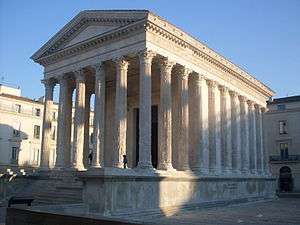Pseudoperipteros

In classical architecture, a pseudoperipteros (a pseudoperipteral building) is one with engaged columns embedded in the outer walls – except the front – of the building. The form is found in Greek temples, especially in the Hellenistic period. In Roman temples, the pseudoperipteral form became usual, where there were columns behind the portico as well. Typically the front has a portico with free-standing columns, but columns on the other three sides of the walls are engaged.
If free-standing columns surrounding the entire building, it is a peripteros. Unlike a peripteros, a pseudoperipteros has no space (peristasis) between the cella (naos, inner chamber) and the outer walls on the sides and rear, so the engaged columns can also be considered to be embedded directly on those walls of the cella.
The temple of Olympian Zeus at Agrigento was a famous Greek example of this style. Its facade also has engaged columns.
A pseudoperipteral building with a portico at each end is a amphiprostyle. Examples include the small Temple of Athena Nike and Temple of Venus and Roma.
Sources
| Wikimedia Commons has media related to Schematic plans of ancient Greek temples. |
- "Pseudoperipteral". Merriam-Webster Dictionary.
- Ten Books on Architecture by Vitruvius Pollio
External links
